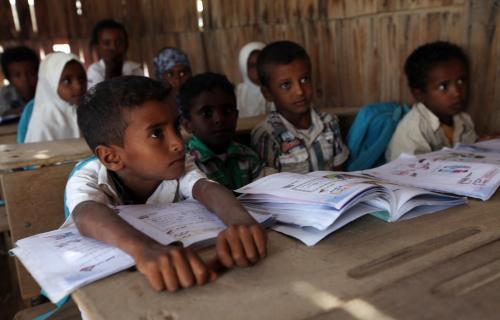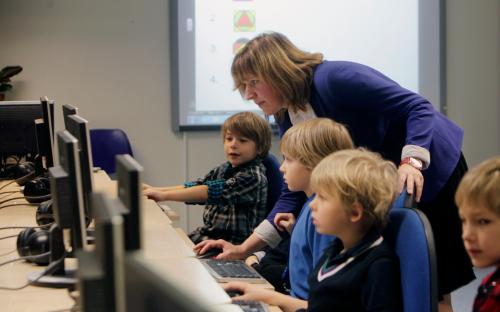This is the second piece in a blog series on NISSEM’s global briefs, a collection of peer-reviewed essays within the field of education.
In the first of our NISSEM global briefs blogs highlighting the role of textbooks for enhancing learning outcomes, we focused on the need for textbooks to be aligned with the mission and vision of the Sustainable Development Goals, and in particular Target 4.7, which calls for ensuring all learners acquire knowledge and skills needed to promote sustainable development. This second post explores how textbooks for basic education levels can be optimized to integrate both pedagogy and content.
In low- and middle-income countries, the textbook has the weight and imprint of authority—especially when the same book is used by all students throughout the country and teachers are obliged to cover its contents from first to last page. But, if laden with definitions and written in high-level language, the textbook can be a barrier to learning, a burden on teachers, and an amplifier of inequity (Table 1).
Table 1. Textbooks: from barriers to carriers

Can these barriers be reshaped around the principles of different perspectives, collaboration, and recognition of diversity, while also supporting cognitive and pro-social learning—even in low- and middle-income countries?
Thinking about the textbook as an amalgam of content and pedagogy—including beliefs about the process of learning in general, as well as within a particular subject and level—can help curriculum and textbook writers address these barriers. In most subjects, the themes and values of Target 4.7, as well as social and emotional learning (SEL), can be expressed as both content and pedagogy. A textbook—whether for math, language, science, or social studies—can be developed and analyzed according to these two dimensions.
In Figure 1, which can represent a starting point for curriculum and textbook developers, there is an axis for pedagogy and another for content: A textbook that is strongly supportive both of pedagogy and content aligned with the social-emotional skills signified by SDG Target 4.7 would be located in the top right quadrant.
Figure 1. Starting points for supportive pedagogy and content


In the NISSEM Global Briefs, blog author Andy Smart provides examples of structured pedagogy within new textbooks for the competency-based curriculum in Bangladesh: each double-page spread presents the curriculum content on the left-hand page, with the right-hand page structured around “Speak” (whole class), “Write” (often in pairs), “Extend” (individual or groups) and “Check.” In the new competency-based textbooks in South Sudan, as described by Vikki Pendry, three principles are followed, which closely link pedagogy to cognitive concepts:
o One learning activity leads to many learning outcomes
o One learning outcome requires a number of learning activities
o Each learning outcome should be part of a carefully constructed sequence of learning.
In Poonam Batra’s paper, new civics textbooks in India made the social world of the learner both an object of study and a process of constantly getting learners to reflect upon their own social experiences, thereby encouraging diversity and inclusion.
Creating an effective textbook
In low- and middle-income countries, these SEL and Target 4.7 themes, values, and skills should be essential dimensions of the cognitive curriculum rather than supplementary lessons. Textbook writers should embed these dimensions within an organizational framework that is built on academic coherence. The NISSEM position paper proposes that in low- and middle-income countries, embedding a 4.7/SEL approach within the core curriculum is more effective in contrast to the standalone SEL programs implemented in OECD countries. In this way, an SEL-based approach is made sustainable and will not become a victim of reduced program funding. Framing a SEL/4.7 approach within a strong cognitive curriculum or textbook plan ensures an appropriate balance of academic, social, and emotional dimensions.
After planning a textbook on the above model of content and pedagogy, writers can avoid creating barriers of high-level language, which may be exacerbated by the language of instruction, and overly dense texts. One of the most widely quoted studies of textbook effectiveness in low- and middle-income countries found that only the highest-attaining students saw any benefit from providing textbooks because the books were in the students’ second language of English.
Typically, lessons in many low- and middle-income country schools are neither teacher-centered nor student-centered; rather, they are textbook-centered, in which the time-poor teacher has little recourse other than to drill students in a text they have little hope of understanding. Additionally, teachers’ own experiences must be taken into account. Textbook reforms cannot succeed without the support of teachers. In their global briefs, Basel Akar and Nayla Hamadeh describe how teachers have collaborated with ministry of education colleagues to transform pedagogy, even where curriculum reform has stagnated for political reasons.
NISSEM advocates for learner-centered pedagogy as long as teachers’ views are taken into account, and for teacher-centered pedagogy as long as students’ views are taken into account. The content for textbooks, including contextualizing SEL priorities, can be generated or tested through focus group meetings with key stakeholders. Among these stakeholders should be former students who have recently completed their education, as well as older youth—whether in work or not—who can testify to the aspects of their education that were personally valuable. Such field-tested content, along with a 4.7/SEL pedagogy, will enable curriculum and textbook reforms for basic, compulsory schooling to produce an exciting, new, and powerful generation of 4.7/SEL-informed textbooks.
The Brookings Institution is committed to quality, independence, and impact.
We are supported by a diverse array of funders. In line with our values and policies, each Brookings publication represents the sole views of its author(s).








Commentary
Rethinking the traditional textbook for better academic and pro-social outcomes
October 18, 2019